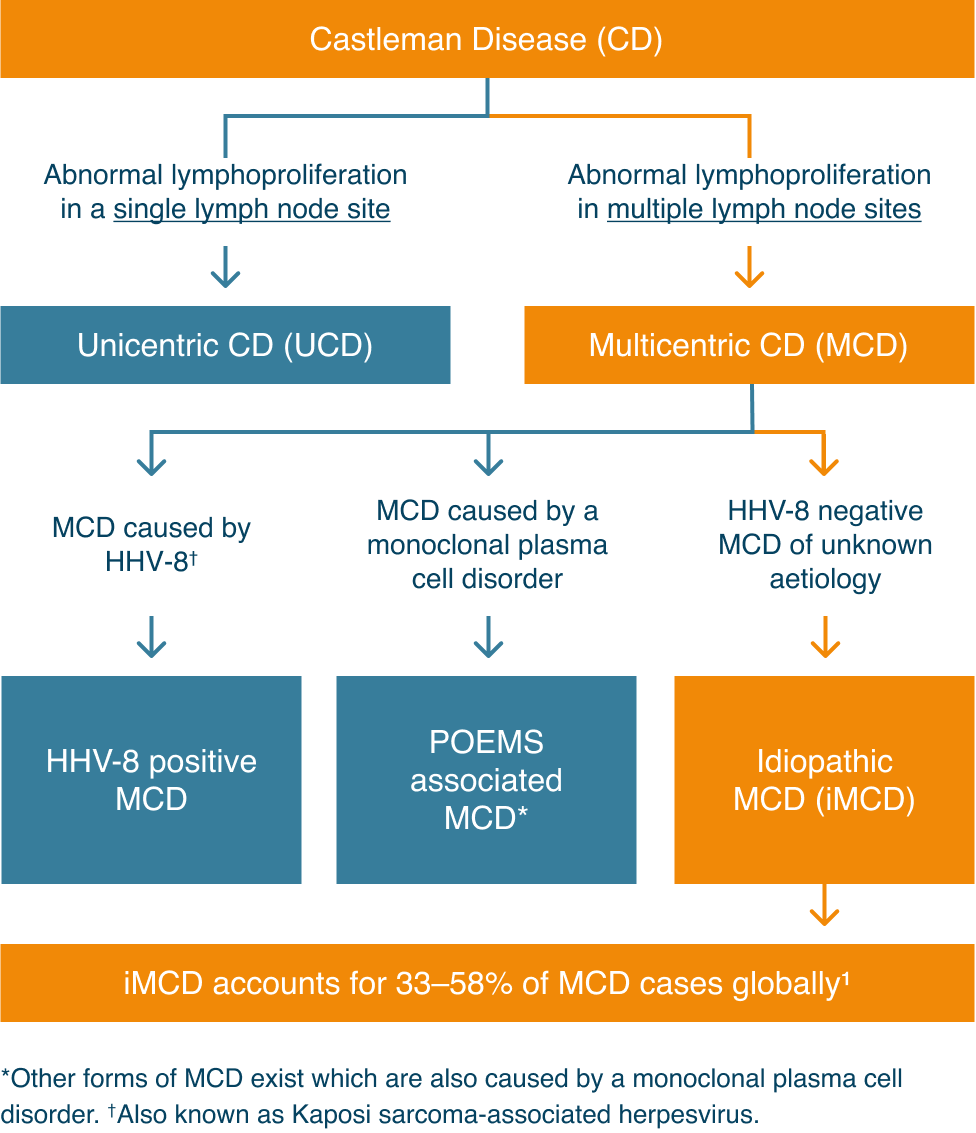
About CD / iMCD
Castleman Disease (CD)
CD refers to a heterogenous group of disorders that share histopathological features of the lymph nodes.
- Despite the shared histopathological features, these disorders have a wide range of aetiologies, presentations, treatments and outcomes1,2
- Multicentric Castleman Disease (MCD) is a subset of CD which presents with lymphadenopathy in
multiple
lymph node sites, and is further divided into three subsets:1,2
- Human herpesvirus-8 positive MCD (HHV-8+ MCD)
- Polyneuropathy, Organomegaly, Endocrinopathy, Monoclonal plasma cell disorder, Skin changes associated MCD (POEMS-MCD)
- Idiopathic MCD (iMCD) with unknown aetiology
Abbreviations: CD, Castleman Disease; HHV-8, human herpesvirus-8;
iMCD, idiopathic Multicentric Castleman Disease; MCD, Multicentric Castleman Disease;
POEMS, polyneuropathy, organomegaly, endocrinopathy, monoclonal gammopathy, skin changes; UCD,
Unicentric
Castleman Disease.
References: 1. Fajgenbaum DC, et al. Blood. 2017; 129: 1646–57.
2. Dispenzieri A and Fajgenbaum DC. Blood. 2020; 135: 1353–64.

- Introduction
- Prognosis
- Potential causes
- Diagnosis
Idiopathic MCD (iMCD) – Introduction
iMCD is a life-threatening and rare disorder. In a real-world, retrospective analysis in the US, the incidence of iMCD was 3.1–3.4 cases per million. In the same study, the prevalence of iMCD was estimated at 6.9–9.7 cases per milllion.*1
*Claims data. Given the methodology used in this study, the incidence likely reflects the incidence of individuals with a new diagnosis, and the prevalence likely reflects the prevalence of individuals with a diagnosis currently listed in their medical record.

Idiopathic MCD (iMCD) – Prognosis
iMCD requires timely diagnosis and treatment at the point of diagnosis to support best possible outcomes.
- iMCD is a chronic disease that progresses in the absence of treatment and can lead to severe comorbidities and death.1–3
- Patients with iMCD have poorer outcomes than many cancers, including Stage II colon cancer, Stage III breast cancer, and progressive non-Hodgkin’s lymphoma.4
- In a real-world, retrospective analysis of US claims data, a significantly higher proportion of patients with iMCD presented with organ failure and/or thrombotic events, compared with a non-iMCD matched cohort (P<0.001).5
- The same analysis, found that patients with iMCD had significantly higher prevalence of several malignancies, compared with a non-iMCD matched cohort (P<0.001).5

Idiopathic MCD (iMCD) – Potential causes
The idiopathic form of CD has no known cause.
- A dysregulated overproduction of IL-6 is the most common pathological driver of iMCD and its symptoms.1,2
- In severe cases, a life-threatening cytokine storm can occur, followed by organ failure and death.2

Idiopathic MCD (iMCD) – Diagnosis
Undiagnosed idiopathic Multicentric Castleman Disease (iMCD) patients exhibit a wide spectrum of possible symptoms.
- There is no ‘typical’ iMCD patient and undiagnosed patients have a range of possible symptoms which will see them under the care of a variety of specialists, e.g., haematologists, rheumatologists, immunologists.1
- Patients are usually referred for an (excisional) lymph node biopsy by their clinician, who has noticed symptoms that require further investigation.1
- Often, the first specialist to suspect iMCD is a pathologist who can identify ‘Castleman Disease-like changes’ in an (excisional) lymph node biposy.1


